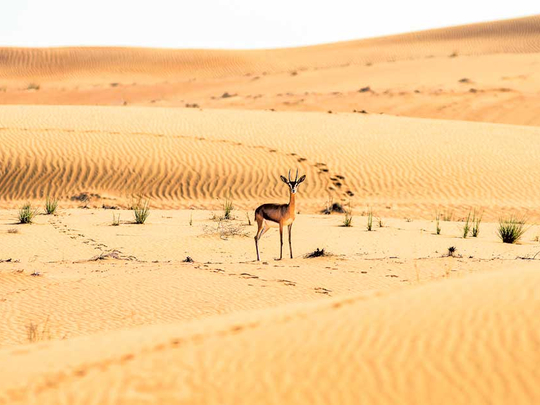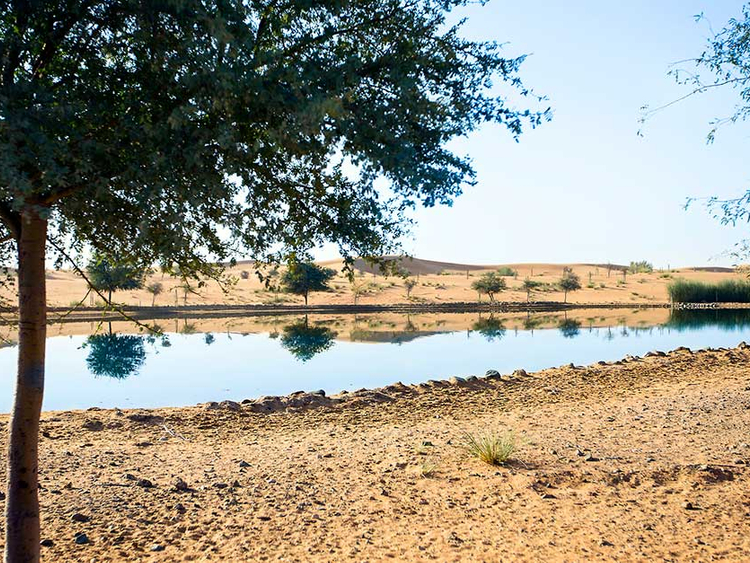
With its endless stretches of undulating dunes that seem to extend all the way to the far horizon, what could one possibly explore in the barren expanse of this desolate desert, I wonder. The early morning haze is yet to clear and all I can see under the canopy of a vast golden sky are miles of ochre sand punctuated by tufts of green. It is breathtakingly beautiful, but beyond that, what other magic can this seemingly uninhabited land hold?
It isn’t until we step down from the confines of the 4x4 that our guide Hendri Du Toit draws our attention away from the rolling dunes and points to the windblown tracks beneath our feet. There, under the early morning light, he shows us the intricate patterns formed in a straight line by the humble dung beetle, a tiny insect that, he says, makes a life by rolling out big balls of dung to feed its offspring. “As lowly as their existence may seem to us, in the desert ecosystem they have a vital role. Dung beetles are recyclers, helping to get rid of waste.”
And therein begins our fascinating introduction to this intriguing landscape and its fragile ecosystem, apparently teeming with life. We are somewhere in the 225-square kilometre Dubai Desert Conservation Reserve, the UAE’s first and largest protected national park, and the morning sun is just beginning to peep from behind the Hajar mountains in the distance. The landscape around us is bathed in a golden glow; it’s a picture-perfect moment; and guiding us on a wildlife spotting adventure is a select team of falconry specialists chosen by Unseen Trails, a collaborative venture between Frying Pan Adventures and Gulf Photo Plus to explore the lesser known parts of Dubai.
Getting down on his haunches, Du Toit, from the Royal Shaheen team of falconers, points out the hoof marks of a fleet-footed Arabian gazelle. Alongside are large, heart-shaped tracks of the oryx. Du Toit explains that this iconic animal of the DDCR has splayed hooves to increase the surface area of the feet, enabling an easier gait on the soft sand. Nearby is a damp spot that, he explains, is the concentrated urine of the oryx whose kidneys are specially adapted to produce minimal liquid waste. “The urine is so concentrated that once it is dry, the sand hardens around it, becoming almost solid.”
According to Du Toit, whose love for wildlife took root in his native South Africa, “Observing the swirled-sands of the desert is like reading nature’s newspaper. It gives you information of all that’s happened on its path since yesterday.”
He asks us to look for drag marks of the gerbil or the rounded paw shapes of foxes but it is when he alerts us to watch out for desert scorpions that are likely to creep up from behind the bushes or camel spiders that flee from the sun and could possibly seek shelter in our shadows, that the group begins to get all squirmy and fidgety. And when he adds that a series of parallel stripes could indicate the side-winding movement of the sand viper, we are ready to dash back to the safety of the vehicle.
We had left the city lights of Dubai at 5am; getting on to the Dubai-Al Ain highway and going past camel race tracks before entering the fenced layout of the DDCR almost an hour later. Driving through the serpentine maze of low-lying sand dunes, Du Toit describes how the Al Maha Resort — now nestled within DDCR — was conceived to preserve a balance between conservation and the rapid expansion of the emirate.
To make it a protected haven for the many species of indigenous mammals and birds of the region, the entire area was fenced off and camels evicted. Large-scale rehabilitation programmes were undertaken, including the propagation of more than 6,000 trees, shrubs and grasses. Seventy Arabian oryx were also re-introduced — they now number around 450.
In 2003, to maintain the last of the remaining pristine desert landscape of the emirate, and to protect the region’s desert habitats and biodiversity, the Al Maha Resort’s original 27-square kilometre area was expanded into the current DDCR. “The DDCR now covers 4.79 per cent of Dubai’s total land area, making it the largest protected landmass in the UAE,” says Hendri.
He emphasises that the DDCR is not a breeding programme. “The focus has been on conservation. Before the DDCR came into being, the Arabian oryx — that once roamed over all or most of the plains and deserts of the Arabian Peninsula — was hunted down nearly to extinction in the wild. The success of the release programmes and the consequent breeding in their natural habitat has made it the first animal to achieve the biggest jump in rankings from endangered to vulnerable status.”
It doesn’t take us long to spot our first oryx of the day — its unmistakable, resplendent white coat shining from far atop a sand dune. Even from that distance, its long straight horns is distinctive; at certain angles, they appear to be a single horn, “giving rise to the enduring myth of the unicorn”, says Du Toit.
Dotted along the sandy plains are broom bushes, a perennial leafless shrub with smooth, slender, green branches which are highly valued in preventing sand erosion. “The animals lick off the moisture that collects on its stems and eat the dry, candy-like blossoms. Beneath these shrubs is also where a host of small animals make their home. So it is not advisable to pitch your tent close to it at night,” he says.
We also spot groves of ghaf trees — the true desert survivors whose long roots can reach water found at 30- to 35-metre depths. The Bedouins used every part of the tree — for food, shelter, shade or medicine — for themselves and their livestock. But it is another fascinating aspect of the Bedouins’ way of life that captivates us as we witness one of nature’s most spectacular sights — up, close and literally, face-to-face — as Du Toit and his colleagues demonstrate the falconry skills the nomadic people had perfected for their survival in the harsh desert a long time ago.
Demonstrating their strength, speed and natural instincts are Romeo, a Saqr falcon; Xbox, a desert owl; and Rogue, a common kestrel. It is Romeo who flies in first, and with a signal from the falconer, quickly dives down for a little reward of fresh meat on Du Toit’s leathered glove. Its small size belies its apparent aggressiveness and according to our guide, it is the falcon’s ability to attack preys bigger than itself that has made it so valuable in the sport of falconry, especially in the Middle East.
“The Bedouins used the falcon to hunt hares or the houbara bustard, a large, wild bird, to supplement their diets; and its significance in the Bedouin culture is why it is the symbol of the UAE,” he says. “And yet, the falcon is not native to the UAE; it is a migratory bird. The Bedouins, who practised the principles of conservation, borrowed the falcon from nature for a brief period only — during winters — and released them back into the wild every summer.”
The show is interactive and we take turns to lure the birds with bits of fresh quail meat. With Xbox seated on my hand, I get a close view of its rich fawn colour, black beak and enormous talons, and am intrigued by its large, piercing orange eyes. Dispelling the myth that owls are wise, Du Toit says that the eyes of the owl take up a large space of its head, leaving very little room for its brain.
Educative and entertaining, the falconers’ wealth of expertise and knowledge helps us connect better with the natural world, kindling in us a yearning to know more.
By now, the sun is up and shining in all its glory, and we head to the shade beside an artificial lake to refuel our body. Spread out before us is a healthy back-to-basics breakfast from local food artisans Baker & Spice, with choices of homemade bread, labneh, cheese, hummus, marmalade and date jam with organic vegetables from farms in the UAE.
We hear from Arva Ahmed, the foodie tour guide behind Frying Pan Adventures that it was the local-organic-fresh-homemade concept at Baker & Spice that made their food the perfect fit for this trip. As we dive in and layer up our sandwiches with organic sliced eggs, olives, tomatoes, cucumbers and lettuce we cannot but agree with her.
To commemorate our visit, each of us plants a ghaf tree donated by Goumbook in the reserve and it is when we head out that we witness a herd of around 40 oryx grouped together at one of the supplementary feeding stations. The joy of observing an animal once extinct in the wild in its natural desert-and-dune surroundings is unparalleled and reaffirms the modern-day conservation success story of the Dubai Desert Conservation Drive.
The Unseen Trails team is one of five companies that have been awarded an exclusive route through DDCR.
The next DDCR #UnseenTrails will be held on November 26. For details, visit www.unseentrails.com/desert
Sangeetha Swaroop is a writer based in Dubai.













